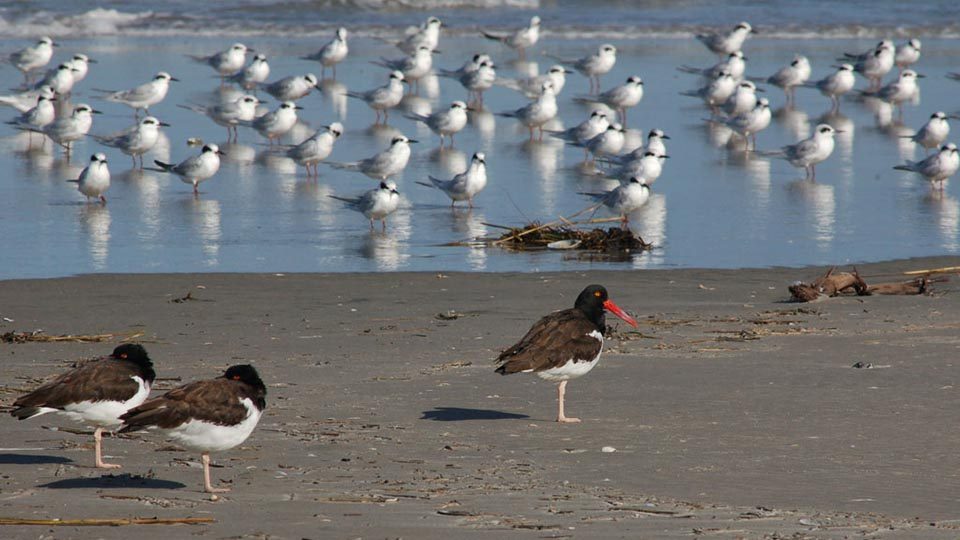Bayshore Oystercatchers
We’re talking birds here, not the mariners of the oyster industry but seafood lovers, nonetheless.


As we walked out onto the deserted Delaware Bay beach, the usual sounds greeted us. Maybe I should rather say “lack of sounds,” because that is a signature of the rural Bayshore. But a naturalist is usually attuned to what is going on in nature, however subtle. The chipping of a marsh wren came from the bushes behind the beach, the distant clucking of a clapper rail from the marsh, the fussing of gulls out on the water. But suddenly we realized that we heard distant, whistled piping from farther down the shoreline. It got louder and closer, and several American oystercatchers came into view. For a split second we had to remember where we were. No, we weren’t on an Atlantic coastal strand, we were on a Delaware Bay beach. The four birds flew rapidly by, leaving sound and wonder in their wake.
Given the heritage of the oyster industry, if one mentions the word oystercatcher on the Delaware Bay people might tend to think of the baymen who work the bay catching these bivalves. And one person to whom I mentioned oystercatchers thought that I was talking about oystercrackers, the colloquial name for the common oyster toadfish found in local waters. But no, we are referencing the American oystercatcher, a large and colorful shorebird found the length of the Atlantic seaboard (as well as in a limited range on the Pacific Coast). Not only is this bird boldly patterned—black and white with a large orange-red bill—but it also is an exceptionally brash and active bird, loudly displaying and always announcing its presence with its loud and insistent piping calls.
The oystercatcher is aptly named, and there is a good reason why they are increasingly showing up on the Delaware Bayshore. American oystercatchers feed mainly on mollusks—clams, mussels, bay scallops and oysters—although they also readily eat small crabs, marine worms, and even a few small fish. Oystercatchers have highly specialized bills that enable them to pry open the shells of their preferred bivalve prey. In New England they will feed on rocky coasts, but mostly they are low-tide feeders on beaches, sandbars, mudflats, and sod banks. They are birds whose lives are governed by the tides, as by necessity they feed during lower stages but roost and rest during the high tide cycle.

While native to New Jersey, oystercatchers were absent for many years, as they were victims of the intense market hunting in the late 1880s. They began to recolonize coastal beaches from the south in the early 20th century; the first modern-day nesting record in New Jersey was in 1947. Since then they have slowly made a comeback, and today they are regularly found during all seasons along Atlantic Coast beaches.
As they have become more abundant through protection, oystercatchers have slowly begun to colonize Delaware Bayshore beaches and adjacent mudflats as well. It is not known if they were historically found on the Bayshore, so maybe it isn’t a comeback per se, but oystercatchers are currently quite at home on Bay beaches.
The first Bayshore report placed a pair north of Reeds Beach in the late 1990s. Since then, surveys carried out by Citizens United to Protect the Maurice River have documented oystercatchers near the mouth of the Maurice River beginning in 2001, at East Point, Heislerville Wildlife Management Area, and Thompson’s Beach. Several pairs have been found to be present since 2004. According to the Endangered and Nongame Species Program of the New Jersey DEP Fish and Wildlife Division, it is currently believed that as many as 20 pairs of American oystercatchers now breed on the Bayshore, scattered from Pierces Point in Cape May County to Fortescue and beyond in Cumberland County.
Today the American Oystercatcher Working Group, in concert with Conserve Wildlife Foundation of New Jersey and the Wetlands Institute, is trying to learn more about Bayshore oystercatchers. They want to assure protection for this iconic bird as it expands beyond Atlantic coastal beaches. It is possible that Bayshore oystercatchers face far different challenges and possible threats than the beach-nesting population on the Atlantic coast.

Next time you visit a Delaware Bay beach, be on the lookout for the colorful and feisty American oystercatcher. Few birds can energize a beach or mudflat in quite the same way. They might be found in any season. While oystercatchers are migratory, sizable flocks remain on the Jersey coast during all but the coldest winters.
Spring comes early for oystercatchers, and you might see them at bayside haunts as soon as March. Breeding begins early too, and this is when they are most vocal and conspicuous. The courtship behavior of oystercatchers is one of the hallmarks of the bird. While monogamous, their breeding rituals often involve a number of birds. Displays are lengthy and involve mutual strutting, bowing, posturing, and lengthy aerial chases. All displays involve loud and constant piping and whistling. One might even call the bird noisy!
Oystercatchers are animated, active, and always fun to watch. As the American oystercatcher colonizes the Delaware Bayshore, keep a sharp eye on all your favorite beaches to see if they are about. You probably won’t miss them if they are there; their plaintive and insistent piping will first give them away. And oystercatchers are now yet another reason to be outdoors on the Jersey Bayshore.
Conserve Wildlife Biologist Emmy Casper will present on Oystercatchers at this year’s 22nd Annual Eagle Festival. The Festival will take place in Mauricetown on Saturday, February 3, from 8 a.m. to 4 p.m. at the Mauricetown Firehall. The festival kicks off with a walk at 7 a.m. on Turkey Point Rd., which the CU World Series of Birding team “The Fish Hawks” will be leading.
About this Week’s Author
 Clay Sutton is a lifelong resident of Cape May County, where he has worked as an environmental planner, environmental program administrator, vice-president of an environmental consulting firm specializing in threatened and endangered species, and for nearly three decades as a self-employed environmental consultant, field biologist, and naturalist. Now mostly retired, Clay has been a freelance writer, lecturer, tour leader, and was a longtime instructor for the Institute for Field Ornithology. The science and wonder of bird migration has remained his captivating interest.
Clay Sutton is a lifelong resident of Cape May County, where he has worked as an environmental planner, environmental program administrator, vice-president of an environmental consulting firm specializing in threatened and endangered species, and for nearly three decades as a self-employed environmental consultant, field biologist, and naturalist. Now mostly retired, Clay has been a freelance writer, lecturer, tour leader, and was a longtime instructor for the Institute for Field Ornithology. The science and wonder of bird migration has remained his captivating interest.
Clay is a co-author, with Pete Dunne and David Sibley, of the classic Hawks in Flight (Houghton Mifflin Harcourt, 1988; Second Edition, 2012), a complete and holistic guide to raptor identification. Clay and wife Pat Sutton co-authored How to Spot Butterflies (1999), How to Spot Hawks & Eagles (1996), and How to Spot an Owl (1994), all published by Houghton Mifflin Harcourt. Their acclaimed book, Birds and Birding at Cape May (Stackpole Books, 2006, 568 pages), is the in-depth result of their efforts over many years documenting and protecting the migration and the area that they so love. This landmark book is a complete guide to birds and birding for Cape May and the entire southern New Jersey region, covering what to see, when, where, and how to go, as well as chronicling the unique and storied ornithological history of the Jersey Cape. In 2002 Clay authored Birding Cumberland, a complete guide to birds and birding in Cumberland County, published by CU Maurice River.









